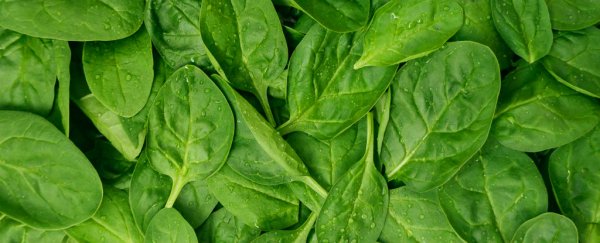For the first time, scientists have figured out how an unusual type of sugar found in green, leafy vegetables feeds the 'good' bacteria living in our guts to aid digestion, while blocking off the 'bad' bacteria that can make us sick.
Known as sulfoquinovose (SQ for short), it's the the only known sugar molecule to contain sulphur, and that's important - sulphur is the third most abundant mineral in the body, and is one of the vital amino acids used to create proteins for cells and tissues, plus many crucial hormones, enzymes, and antibodies.
"Sulphur is critical for building proteins, the essential components of all living organisms," said one of the researchers, Spencer Williams from the University of Melbourne in Australia. "SQ is the only sugar molecule which contains sulphur, and 'digestion' of the molecule by bacteria releases sulphur into the environment, where it re-enters the global 'sulphur cycle' to be reused by other organisms."
SQ is produced by all green plants to facilitate photosynthesis, and the greener the plant, the more it contains. According to Rae Johnston over at Gizmodo, each year, leafy green vegetables around the world produce the sugar on a scale comparable to the world's total annual iron ore production.
The only problem? Humans can't digest it. "No one had any idea where it went or what happened to it when the plant died," lead researcher, Ethan Goddard-Borger from the Walter and Eliza Hall Institute in Melbourne, told The Sydney Morning Herald. "But it is actually being used by bugs that live in the gut to promote their growth, which is a good thing for you."
While scientists have known about SQ's presence in leafy greens, such as spinach, broccoli, kale, and parsley, for many years, for the past five decades, no one's been able to figure out how bacteria in our gut extract it from the vegetables to use as an energy source.
Now the Australian team has identified a previously unknown enzyme called YihQ that bacteria use to isolate, absorb, and metabolise these sulphur-containing sugars..
"Bacteria in the gut, such as crucial protective strains of E. coli, use SQ as a source of energy. E. coli provides a protective barrier that prevents growth and colonisation by bad bacteria, because the good bugs are taking up all the habitable real estate," Goddard-Borger explains in a press release.
"E. coli is a key bacterial coloniser needed by our gut. We speculate that consumption of this specific molecule within leafy greens will prove to be an important factor in improving and maintaining healthy gut bacteria and good digestive health."
Not only does the discovery, published in Nature Chemical Biology, solve a 50-year-old mystery about how one of the most abundant sugar molecules in the world gets recycled from plant to plant, it opens up the possibility of an entirely new class of antibiotics.
Because harmful bacteria - such as food-poisoning culprit, Salmonella - also metabolise this sugar, the team suggests that SQ-based antibiotics could be developed that specifically attract certain types of pathogens and kill them from the inside-out. And if there's one thing we need right now, it's new kinds of antibiotics.
